5.4: Seventh Chords and Inversions
- Page ID
- 52043
We learned earlier that triads can be created on each scale step or each scale degree. In a similar manner, seventh chords can be created by stacking additional notes a third above the triads. Root position seventh chords when stacked as closely as possible have all notes either on spaces or all on lines. For instance, see the example of seventh chords on scale degrees in C Major (Figure 1):

Let’s carefully examine the quality of each chord. The triads (lowest three notes) are either major, minor, or diminished when built on the C major scale. The sevenths are either major or minor 7ths (Figure 2):

The first letter in Figure 2 refers to the quality of the triad; the second letter to the quality of the seventh. For instance, in the first chord built on C the triad is major, “M,” and the seventh is also major, “M.” In the second seventh chord both the triad and seventh are minor, “m.”
One seventh chord deserves special attention. The dominant seventh chord is the most prominent seventh chord in common practice music. It is distinct from the other seventh chords since it is the only one possessing a major triad with a minor seventh. The dominant seventh, whether in a major or minor key, is always a major triad with a minor seventh above the root of the chord. Figure 3 supplies a dominant seventh chord built on G:
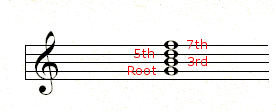
Inversions of Seventh Chords
Here is an easy way to remember the inversions of seventh chords:
7 – 65 – 43 – 2
Notice the descending pattern of numbers. The root position and three inversions use this order of numbers to label the chords. Figure 4 gives a tonic seventh chord built on C with the root position and inversions:

Figure 5 demonstrates how the inversions are obtained. The bass note (C4) in the root position triad is moved up an octave to C5 for the 1st inversion. Similarly the bass notes in the 1st inversion is transposed up an octave for the 2nd inversion, etc.

Observe that an alternative way to label the 3rd inversion is 4 over2.
Recognizing Inversions of Seventh Chords
Take these steps to recognize inversions of seventh chords. 1) stack the chord in closed position (as closely as possible) with the bass as the lowest note. Remove duplicated pitches. 2) find the second in the chord. The root of the chord will be the top note of that second. 3) If the root is the top note the chord is 1st inversion, 2nd from the top—2nd inversion, 3rd from the top—3rd inversion. Figures 6 and 9 supplies examples of the process:
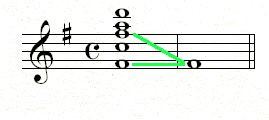
The bass is written first to the right. The redundant (extra) F# is not added to the revised chord.
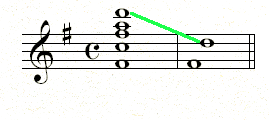
The D is added to the new chord.
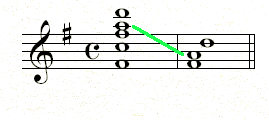
The A is added.
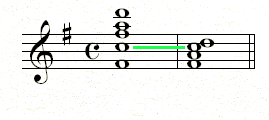
Finally the C is added and all the notes are in the new closed position chord. Notice that the second--the non-third interval--is easy to identify. All the chord tones are on spaces except for the root--D5. This root forms a second with the note below it. Since the root is on the top of the chord, this is a first inversion seventh chord. Here is the harmonic analysis (Figure 10):
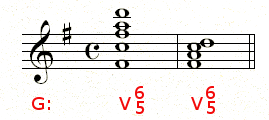
Practice labeling these seventh chords in G major (Answers below)

Answers: G Major: 1. ii7, 2. V7, 3. I65, 4. V43, 5. IV65, 6. V2


